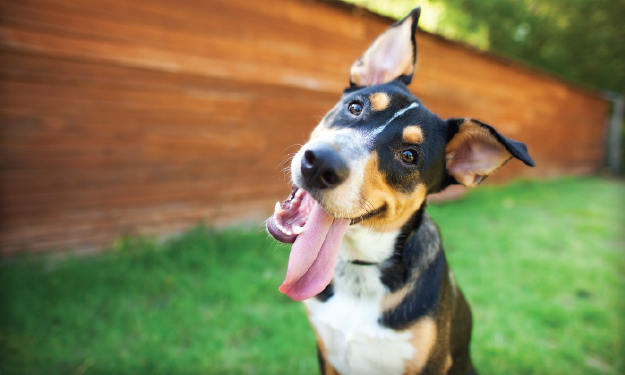The Dangers of Heatstroke

The spring and summer months are a great time to get out and about with our canine family members. Unfortunately heatstroke is a life-threatening condition that is more likely to occur during warmer months when dogs may over exercise in the heat and humidity or be left unattended in vehicles. Heatstroke can also develop more easily in some dogs with preexisting health conditions such as obesity, laryngeal paralysis or brachycephalic airway syndrome (BAS).
A normal body temperature in dogs is closely maintained so that ideal cellular function can occur. This is a complex process that results in a balance between heat production and heat loss. Body heat is generated by metabolism and muscle activity. Heat that is produced by the body can be retained to allow maintenance of the core body temperature. In order to prevent hyperthermia (an elevated body temperature) methods of heat loss are required to maintain an ideal body temperature.
The four main mechanisms of heat loss from the body are evaporation, conduction, convection and radiation.
Evaporation is a loss of heat from moisture on the body surface. In dogs panting allows respiratory heat loss via the evaporative route.
Conduction is the transfer of heat from body surfaces to objects contacting the body, such as floors.
Convection is the transfer of body heat to the air surrounding the body.
Radiation is the transfer of heat from the body to surfaces surrounding the body that are not in direct contact with the body. In dogs, conduction and convection are the primary means of heat dissipation from the body.
Heatstroke is a cause of life-threatening hyperthermia (> 104 F) that results from inadequate heat dissipation from the body.
Classic heatstroke occurs due to exposure to high environmental temperatures which antagonizes the body’s ability to offload heat by means of convection and radiation. The most common situation of classic heatstroke is a dog locked in a closed car where the interior temperature can rapidly increase past the outside ambient temperature due to solar heat and poor interior ventilation. This situation occurs more rapidly in larger or overweight dogs that produce greater body heat.
Exertional heatstroke is the result of physical activity in a hot and/or humid environment. Increased environmental humidity decreases respiratory evaporative heat loss due to the already increased moisture in the air. Panting results in increased work of breathing and increases heat production which further exacerbates this condition.
Many cases of exertional heatstroke occur early in the warm weather season due to lack of acclimatization to the change of temperature. Dogs with altered means of respiratory evaporative heat loss, such as brachycephalic dogs and dogs suffering from laryngeal paralysis, may be more vulnerable to both exertional and classic heatstroke. Obesity and a thick hair coat can also decrease the ability to dissipate heat from the body in both forms of heatstroke. It is believed that some dogs may have a genetic resistance to heatstroke due to increased levels of heat shock proteins (HSP) which are believed to protect and repair cellular proteins from heat damage.
Signs of heatstroke depend on the extent of temperature elevation, duration of temperature elevation, as well as individual dog factors.
Diagnosing heatstroke is often based on a history of confinement or exertion on a hot, humid day. Most dogs with heatstroke will have an elevated body temperature, fast heart rate, will be panting, and have dark pink mucous membranes. In dogs with significant heatstroke cellular functions can be altered resulting in heart arrhythmias (abnormal rhythms), neurological signs including depression, coma and seizure activity and damage to kidney cells that can result in kidney failure. Severe heatstroke can also damage proteins in the body resulting in altered and decreased ability to clot blood.
Any dog that is believed to have developed heatstroke should have immediate care. The main treatment that owners can do is to immediately remove the dog from the hot environment and spray the dog with cool water as soon as a heatstroke incident is identified.
Dousing the dog in cool water and placing them in front of a fan is the best way to cool the dog by allowing transfer of heat from the core to the skin and subsequently to the environment. Ice water is to be avoided as it will induce peripheral vasoconstriction and inhibit heat radiation from the skin. Ice water may also induce shivering which will result in heat generation. Once a dog has been sprayed with cool water the dog should then be transported to a veterinarian for further stabilization and care with IV fluids and additional symptomatic and supportive care.
Heatstroke is a serious condition and prognosis is dependent on many factors including duration of temperature elevation, extent of temperature elevation, rapidity of initiation of treatment and the development of complications. Poor prognostic indicators include progressive decline in neurological status, worsening kidney function, heart arrhythmias and altered blood clotting ability.
While prompt cooling and veterinary care is the best treatment of heatstroke, prevention of heatstroke is ideal. Being aware of dogs that may have altered tolerance of high temperatures such as brachycephalics (Bulldogs, Pugs, Boston Terriers, French Bulldogs) and not allowing activity during times of high heat and/or humidity is recommended. Dogs with a diagnosis of laryngeal paralysis, heart or respiratory disease should also be restricted and monitored closely.
At no time should any dog be left in a car during the spring and summer months. During activity in the heat, ample fresh water should be provided as well as frequent rest in the shade or escapes to the air conditioned indoors. If a dog is found unattended in a car in the heat, all attempts should be made to locate the owners and to free the dog.